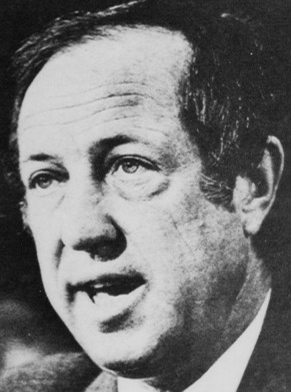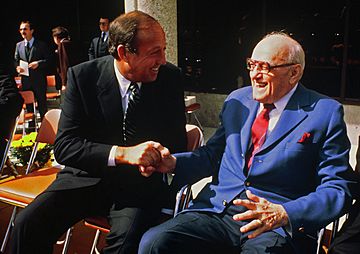Pete Rozelle facts for kids
Quick facts for kids
Pete Rozelle
|
|
|---|---|

Rozelle in 1975
|
|
| 4th Commissioner of the National Football League |
|
| In office January 1960 – November 1989 |
|
| Preceded by | Austin Gunsel (interim) |
| Succeeded by | Paul Tagliabue |
| Personal details | |
| Born |
Alvin Ray Rozelle
March 1, 1926 South Gate, California, U.S. |
| Died | December 6, 1996 (aged 70) Rancho Santa Fe, California, U.S. |
| Spouses |
|
| Children | 1 |
| Alma mater | University of San Francisco |
|
Football career |
|
|
Pro Football Hall of Fame
|
|
Alvin Ray "Pete" Rozelle (born March 1, 1926 – died December 6, 1996) was an important American sports leader. He was the commissioner of the National Football League (NFL) for almost 30 years. He served from January 1960 until he retired in November 1989.
Rozelle became the youngest commissioner in NFL history at just 33 years old. Many people believe he helped make the NFL one of the most successful sports leagues in the world. During his time, the NFL grew from 12 teams to 28. He also helped create big television deals, like Monday Night Football in 1970. He oversaw the 1970 AFL–NFL merger, which brought two leagues together. This merger also led to the creation of the Super Bowl. By the time he retired, many saw him as the most powerful person in sports. He was added to the Pro Football Hall of Fame in 1985.
Contents
Pete Rozelle's Early Life
Pete Rozelle was born in South Gate, California. He grew up nearby in Lynwood during the Great Depression. He finished high school in 1944. He played tennis and basketball. In 1944, he joined the U.S. Navy and served for 18 months. He was on an oil tanker in the Pacific Ocean during World War II.
After the Navy, Rozelle went to Compton Community College. There, he worked with student athletes and also helped the Los Angeles Rams football team. He worked as a public relations assistant. Later, he got a scholarship to the University of San Francisco (USF). He worked in a similar role for the USF sports teams. He helped promote the school's football team. He also helped the USF basketball team get national attention when they won a championship in 1949. After graduating in 1950, he became the full-time athletic news director at USF.
In 1952, he went back to work for the Rams. He was a public relations specialist. After three years, he took other public relations jobs in California. In 1957, he returned to the Rams as their general manager. The team was struggling, but he helped them become a business success in just three years.
Leading the NFL: Commissioner Rozelle
Building the League in the 1960s
In January 1960, Pete Rozelle was chosen as the new NFL commissioner. He was a surprise choice at 33 years old. When he started, the NFL had 12 teams. Games often had many empty seats. Only a few teams had TV deals.
One of Rozelle's first big achievements was helping the league share money. Teams started sharing money from ticket sales and TV deals. This helped smaller teams succeed. Rozelle also got big TV contracts to show every NFL game. He was very good at working with different TV networks. In 1962, he was re-elected as commissioner.
A Tough Decision: The Kennedy Assassination
On November 22, 1963, President John F. Kennedy was killed. Rozelle had to decide if NFL games should be played that Sunday. He talked to a friend who worked for the White House. His friend suggested playing the games. Rozelle agreed, saying that football was President Kennedy's favorite sport. He felt athletes should perform even in sad times.
Some players and news reporters did not agree with his decision. Later, Rozelle thought it might have been better to cancel the games. Other sports leagues, like the American Football League (AFL), did cancel their games that weekend. For his leadership, Sports Illustrated magazine named Rozelle their "Sportsman of the Year" in 1963.
Merging Leagues: The Super Bowl Begins
By 1965, the rival American Football League (AFL) was getting stronger. They had a new TV deal and signed star players. The NFL and AFL were competing to sign the best players. This made player salaries go up a lot. In 1966, the two leagues agreed to merge.
Part of the agreement was to have a common draft for players. They also agreed to play a championship game between the two league winners. This game was first played in early 1967. It was called the AFL-NFL World Championship Game. It later became known as the Super Bowl. Rozelle helped lead the talks to merge the leagues. He also convinced the U.S. Congress to allow the merger. He played a big part in making the Super Bowl the most watched sports event in the United States.
The AFL and NFL stayed separate for games until 1970. But they played each other in the preseason and in the championship game. During this time, the NFL added new teams like the Atlanta Falcons and New Orleans Saints. The AFL also added the Miami Dolphins and Cincinnati Bengals. In 1970, the AFL officially joined the NFL. The league was reorganized into two conferences: the American Football Conference (AFC) and the National Football Conference (NFC). By 1970, the NFL had 26 teams.
New Ideas: Monday Night Football and Growth
In 1970, Rozelle came up with the idea for Monday Night Football. He presented his idea to the ABC television network. The first Monday Night Football game was in September 1970. It featured the Cleveland Browns against the New York Jets. This show was very popular and is still broadcast today. Monday Night Football was on ABC for 36 seasons. In 2006, it moved to ESPN.
The NFL continued to grow. In 1976, two more teams were added: the Tampa Bay Buccaneers and the Seattle Seahawks. This brought the league to 28 teams. This number stayed the same for the rest of Rozelle's time as commissioner.
Challenges and Changes in the 1980s

In the 1980s, Al Davis, who owned the Oakland Raiders team, wanted to move his team to Los Angeles. The NFL tried to stop him. Rozelle represented the NFL in court. The NFL lost the case, and the Raiders moved to Los Angeles in 1982. There was a lot of tension between Rozelle and Davis. After the Raiders won Super Bowl XV in 1981, Rozelle had to present the Super Bowl Trophy to Davis. The Raiders later moved back to Oakland in 1995.
Rozelle's Lasting Impact
Under Pete Rozelle, the NFL became a huge part of American culture. This happened even with two player strikes and two other competing leagues. He retired as commissioner on November 5, 1989. By the time he left, the league had grown to 28 teams. Team owners were making a lot of money from TV deals.
Rozelle's idea of sharing money and resources helped make the NFL strong. This idea also influenced other sports leagues. For example, the Australian Football League adopted a similar policy in 1986. This helped new teams and smaller teams in Australia survive and succeed.
Awards and Recognition
Pete Rozelle was inducted into the Pro Football Hall of Fame in 1985. This happened while he was still the commissioner. The NFL created the annual Pete Rozelle Radio-Television Award in 1989. This award honors people who have made great contributions to professional football on radio and television.
In 1990, the league also created the Pete Rozelle Trophy. This trophy is given to the Super Bowl MVP. It was first awarded in 1991 at Super Bowl XXV. After Rozelle's death in December 1996, the NFL honored him. They put a special sticker on the helmets of the teams playing in Super Bowl XXXI.
In 1990, Rozelle received the Golden Plate Award from the American Academy of Achievement. He also received the "Lombardi Award of Excellence" in 1991. For his contributions to sports in Los Angeles, he was honored with a plaque at the Los Angeles Memorial Coliseum.
About Pete Rozelle's Life
Pete Rozelle married Jane Coupe in 1949. They had one child, Anne Marie, born in 1958. He later married Carrie Cooke in December 1973.
On December 6, 1996, Pete Rozelle died from brain cancer. He was 70 years old. He passed away seven years after retiring. He was buried in El Camino Memorial Park in San Diego.
See also
- List of notable brain tumor patients

